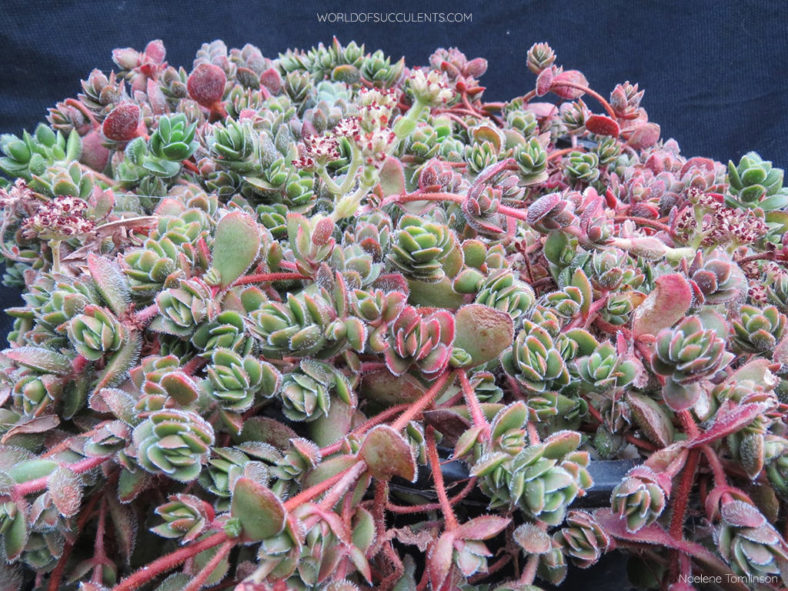Scientific Name
Crassula lanuginosa var. pachystemon 'David'
Synonym(s)
Crassula 'David'
Scientific Classification
Family: Crassulaceae
Subfamily: Crassuloideae
Genus: Crassula
Origin
Crassula lanuginosa var. pachystemon 'David' is a form of Crassula lanuginosa var. pachystemon collected by David Cumming in South Africa in the 1980s. It was named for him by Rudolf Schulz.
Description
Crassula lanuginosa var. pachystemon 'David', also sold as Crassula 'David', is a small, compact succulent with reddish branches and dark green leaves with fine, white hairs along the margins and more or less on the lower surface. The branches are fleshy, prostrate to decumbent, and can grow up to 4 inches (10 cm) long. The fleshy leaves are disk-shaped and turn red as the weather gets cooler.
The white flowers appear in clusters on short stems in winter and early summer.

How to Grow and Care for Crassula lanuginosa var. pachystemon 'David'
Light: C. lanuginosa var. pachystemon 'David' prefers full sun to partial shade. However, intense afternoon sun in the hottest period of summer can burn the leaves of the plant. Therefore, a place with morning sun and afternoon shade would be perfect. Indoors, place your plant in a window that receives at least 6 hours of direct sunlight.
Soil: This plant is not particular about soil pH but requires very porous soil with excellent drainage. Use commercial potting soil mixes designated for succulents or mix your own.
Temperature: Like most Crassulas, this succulent will tolerate short-term freezing, but extremes of cold or heat will cause it to lose leaves and die. C. lanuginosa var. pachystemon 'David' can withstand temperatures as low as 25 °F (-3.9 °C). USDA Plant Hardiness Zones 9b to 11b, 25 to 50 °F (-3.9 to 10 °C).
Watering: Avoid overwatering by using the "soak and dry" method, where the soil is soaked with water, slowly drained, and left to dry out before watering again. Reduce watering in winter. Potted plants require more frequent watering than those in the ground.
Fertilizing: C. lanuginosa var. pachystemon 'David' does not need much feeding but will benefit from a small amount of organic fertilizer in mid-spring when it starts actively growing.
Repotting: Repot as needed, preferably in spring, at the beginning of the active growth period. Make sure the soil is dry before you begin repotting.
Propagation: This succulent is generally started by leaves or stem cuttings. It can also be grown from seeds and offsets. The easiest way is to propagate C. lanuginosa var. pachystemon 'David' from a single leaf while using stem cuttings is the fastest way to get a decent-sized plant. These processes are most successful if done at the beginning of the plant's active growth period. Sow the seeds in the spring or summer.
Learn more at How to Grow and Care for Crassula.
Toxicity of Crassula lanuginosa var. pachystemon 'David'
C. lanuginosa var. pachystemon 'David' is nontoxic to people and pets.
Links
- Back to genus Crassula
- Succupedia: Browse succulents by Scientific Name, Common Name, Genus, Family, USDA Hardiness Zone, Origin, or cacti by Genus
Photo Gallery
Click on a photo to see a larger version.


